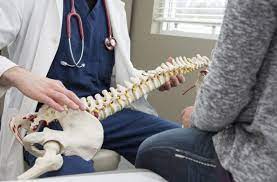Contact Dr. Fronzaglia in Coral Springs, Florida For Spinal Decompression Treatment
Spinal decompression has been an important part of my practice for some years now, and while it is a remarkably effective treatment for the vast majority of patients suffering from the symptoms of herniated and/or degenerated spinal discs, it is not an appropriate treatment for every patient with back pain. Sadly, the financial investment involved in providing spinal decompression services appears to sometimes influence doctors to recommend it in cases where it may not be necessary or indicated. No treatment is 100% effective, but when doctors are not as discriminating as they should be in what patients they accept, the results can be far from ideal. Even more concerning is the possibility that some patients may even get worse with this form of treatment when doctors prescribe it inappropriately for financial reasons.
Spinal decompression is an advanced form of spinal traction used in the treatment of disc-related back pain and related conditions such as sciatica. The primary difference between true spinal decompression and traction (and inversion) machines is that spinal decompression machines are set up to "trick" the spinal muscles into staying relaxed during treatment, allowing for greater changes in disc pressure than with regular traction, which has to fight the resistance of the muscles. As someone who previously used regular traction with my patients, I can attest to the fact that true decompression systems provide dramatically better results overall. Spinal decompression treatment provides excellent results for many people, but some fail to get any improvement at all, and others may even feel worse. I will attempt to explain the most common reasons for these treatment failures, and give suggestions for how to know when spinal decompression is and is not likely to help you.
Judging from my experience, the best patients for this form of treatment are the ones who have one or more bulging or herniated spinal discs and/or mild to moderate degeneration of the discs. Those patients who have previously had disc surgery still make good candidates for spinal decompression, provided they do not have any specific issues that would exclude them, such as metal implants in the spine, spinal instability, and/or some form of healing impairment at the site of the surgery. The large majority of patients who qualify under these criteria will typically get excellent results and be able to resume their daily activities without any major pain after going through the recommended spinal decompression treatment protocol.
Spinal decompression is an advanced form of spinal traction used in the treatment of disc-related back pain and related conditions such as sciatica. The primary difference between true spinal decompression and traction (and inversion) machines is that spinal decompression machines are set up to "trick" the spinal muscles into staying relaxed during treatment, allowing for greater changes in disc pressure than with regular traction, which has to fight the resistance of the muscles. As someone who previously used regular traction with my patients, I can attest to the fact that true decompression systems provide dramatically better results overall. Spinal decompression treatment provides excellent results for many people, but some fail to get any improvement at all, and others may even feel worse. I will attempt to explain the most common reasons for these treatment failures, and give suggestions for how to know when spinal decompression is and is not likely to help you.
Judging from my experience, the best patients for this form of treatment are the ones who have one or more bulging or herniated spinal discs and/or mild to moderate degeneration of the discs. Those patients who have previously had disc surgery still make good candidates for spinal decompression, provided they do not have any specific issues that would exclude them, such as metal implants in the spine, spinal instability, and/or some form of healing impairment at the site of the surgery. The large majority of patients who qualify under these criteria will typically get excellent results and be able to resume their daily activities without any major pain after going through the recommended spinal decompression treatment protocol.
In conclusion, spinal decompression is usually an extremely effective treatment for people suffering with pain from bulging and degenerated discs, but it is important that doctors select patients for this treatment carefully and make sure that the technicians operating the equipment get refresher training regularly.
Dr. Fronzaglia is specializes in spinal decompression in Coral Springs, Florida. For more information about this form of treatment, visit the Spinal Decompression Coral Springs, [https://www.championchiropractic.com/] website and get spinal treatment options for them.



Comments
Post a Comment